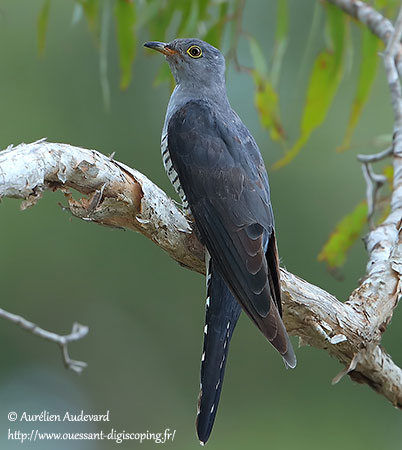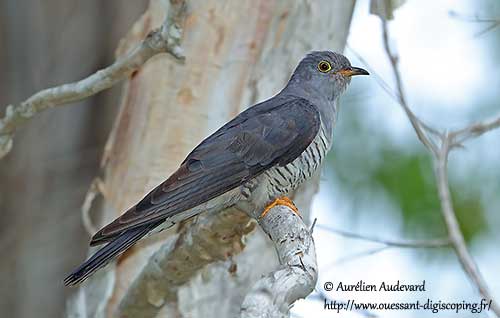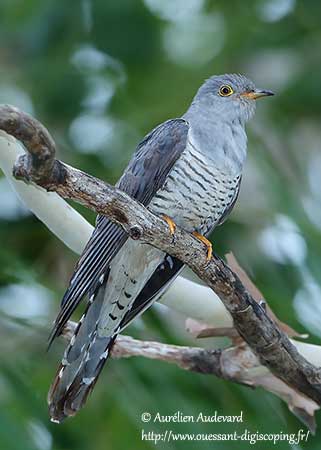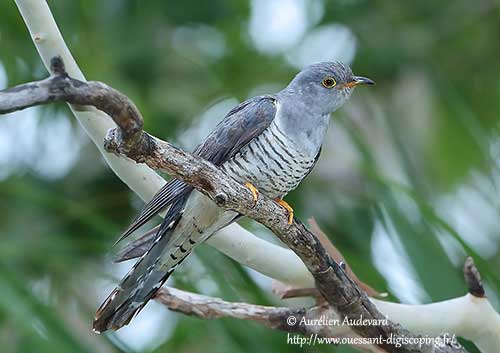
Fr: Coucou oriental
Ang (IOC): Oriental Cuckoo
All: Horsfieldkuckuck
Esp: Cuco de Horsfield
Ita: Cuculo orientale
Nd: Boskoekoek
Sd: tajgagök
Photographer:
Aurélien Audevard
OUESSANT DIGISCOPING
Text by Nicole Bouglouan
Sources:
HANDBOOK OF THE BIRDS OF THE WORLD vol 4 by Josep del Hoyo-Andrew Elliott-Jordi Sargatal - Lynx Edicions - ISBN: 8487334229
A Field Guide to the Birds of South-East Asia by Craig Robson. New Holland Publishers. ISBN: 9781780090498
Cuckoos of the World Par Johannes Erritzøe, Clive F. Mann, Frederik Brammer, Richard A. Fuller – Editeurs A&C Black, 2012 – ISBN: 1408142678, 9781408142677
Field Guide to Australian Birds by Michael Morcombe - Editeur: Steve Parish Publishing Pty Ltd – ISBN-10: 187628210X - ISBN-13: 978-1876282103 - 448 pages
The Graham Pizzey & Frank Knight Field Guide to the Birds of Australia - Publisher: HarperCollins Publishers (Australia) Pty Ltd; Reprint. Edition (1996) - ISBN-10: 020718013X - ISBN-13: 978-0207180132 - 528 pages
Birdlife International (C. saturatus)
What Bird-The ultimate Bird Guide (Mitchell Waite)
Wikipedia, the free encyclopaedia
Oriental Cuckoo
Cuculus optatus
Cuculiformes Order – Cuculidae Family
INTRODUCTION:
The Oriental Cuckoo was formerly classified as a subspecies of Cuculus saturatus (Himalayan Cuckoo) with the same name “Oriental Cuckoo”. They are now separate species with distinct songs, and different size and plumage pattern.
The Oriental Cuckoo breeds in a large range in N Eurasia to N China, Korea and Japan. It winters from SE Asia to Australia.
It usually frequents coniferous, deciduous and mixed forests. Its diet includes mainly insects and their larvae, caught in trees and bushes but also on the ground.
This species is a brood-parasite and the female lays her eggs in the nests of several small passerines, especially warbler species.
The Oriental Cuckoo has currently stable population and the species is not globally threatened.
DESCRIPTION OF THE BIRD:
Biometrics:
Length: 32-33 cm
Wingspan: 70-71 cm
Weight: 73-139 g
The Oriental Cuckoo is very similar to the Common Cuckoo (Cuculus canorus). It is a slender, medium-sized cuckoo, with a shape reminiscent of a small falcon.
The adult male has grey head, neck and upper breast, contrasting strongly with the heavily barred black lower breast and belly. Upperwing and back are dark grey. The long, dark grey tail is conspicuously barred with white. The white underparts are barred with black.
The bill is black with orange-yellow base. The eyes are yellow to brown/brownish-orange, surrounded by yellow eyering. Legs and feet are orange yellow.

The main colour morph is grey (all males) but there is a rufous morph only on females.
The female of rufous morph has pale face and chin and underparts, with dark barring extending from chin to undertail-coverts. On the upperparts, crown, nape, back, rump, upperwing and tail are rufous and strongly barred with dark brown. The bare arts are as for the grey morph.
The female of grey morph resembles male, but she has rufous tinge on the breast.
The juvenile is grey-brown above with white barring to the blackish feathers of crown, nape, throat and breast. The eyes are brown. Two morphs, grey and rufous, may occur in both sexes as young, but all adult males are grey.
RANGE:
The Oriental Cuckoo breeds in European Russia E through Siberia to Kamchatka, S to Kazakhstan, the Altai, Mongolia, and N China, Korea and Japan.
It winters from SE Asia to Australia.
HABITAT:
The Oriental Cuckoo usually frequents various forest types including coniferous, deciduous and mixed forests. It also occurs in farmland with scattered trees.
In the winter range, it can be occasionally found in swamps, mangroves and plantations. In New Zealand, it can be seen in lightly forested areas and sometimes in suburban gardens.

CALLS AND SONGS: SOUNDS BY XENO-CANTO
The Oriental Cuckoo is usually silent in the non-breeding range, but in New Zealand, it was observed while uttering a quiet “tsoo-tsoo-tsoo…” about a dozen times at one second intervals in October 1971.
The Oriental Cuckoo male usually produces a mellow whistled “hoop-hoop”. However, the call of the territorial male is a deep, booming, two-noted sound, often preceded by several quick notes on one pitch ‘hoop-op hoop-op…” or “hoop-hoop…hoop-hoop…”. We can also hear hoarse croaks, chuckles and a harsh “gaak-gaak-gak-ak-ak”.
The female utters a rapid series of sharp “kwit-wik” notes rising in both pitch and volume, ending with an offset low note.
BEHAVIOUR IN THE WILD:
The Oriental Cuckoo feeds mainly on insects and their larvae. Caterpillars are also part of the diet, both hairless and hairy.
Insects include several species such as grasshoppers, crickets, large beetles, cicadas, mantid, flies, wasps, ants and some spiders.
It usually forages in flight and on the ground. It often stays inside tree foliage, but from some observations, the bird may also perch in the open while searching for prey. Once the prey is detected, it swoops to the ground to catch it before to return to the same perch. It feeds alone or in small groups.

The Oriental Cuckoo is a brood-parasite. The female lays her eggs in the nests of small passerines such as Eurasian warblers of genus Phylloscopus including Willow Warbler or Arctic Warbler and Common Chiffchaff, and some others. It selects the hosts with well-concealed nests.
The Oriental Cuckoo is vagrant in New Zealand, and also on some islands including Lord Howe, Norfolk, Snares and Christmas Islands, and Aleutian Islands and Bering Sea islands, Alaska, New Britain, Israel, Iran and the Crimea.
They migrate in loose groups of 10 or more.
The Oriental Cuckoo flies with the wings kept low, not raising them above the horizontal plane, with deep, down stroke ending well below the body.
REPRODUCTION OF THIS SPECIES:
The breeding season varies depending on the range, but this species breeds during the breeding season of the small warblers, between March and August throughout the range.
The Oriental Cuckoo is a brood-parasite. The female usually lays one egg per nest, rarely two. Egg colour varies from reddish-brown to buff, white or bluish-white with brown markings.
The eggs are incubated by the hosts for about 12 days. At hatching, the chick is naked and it has a conspicuous orange gape. Within a few days, it usually ejects the host’s eggs out of the nest. It fledges about 17-19 days after hatching. Several eggs are laid each season by the female cuckoo.
PROTECTION / THREATS / STATUS:
The Oriental Cuckoo is a fairly common visitor in summer to China and Japan.
The species has stable population and it is not globally threatened.
The Oriental Cuckoo is currently evaluated as Least Concern.
